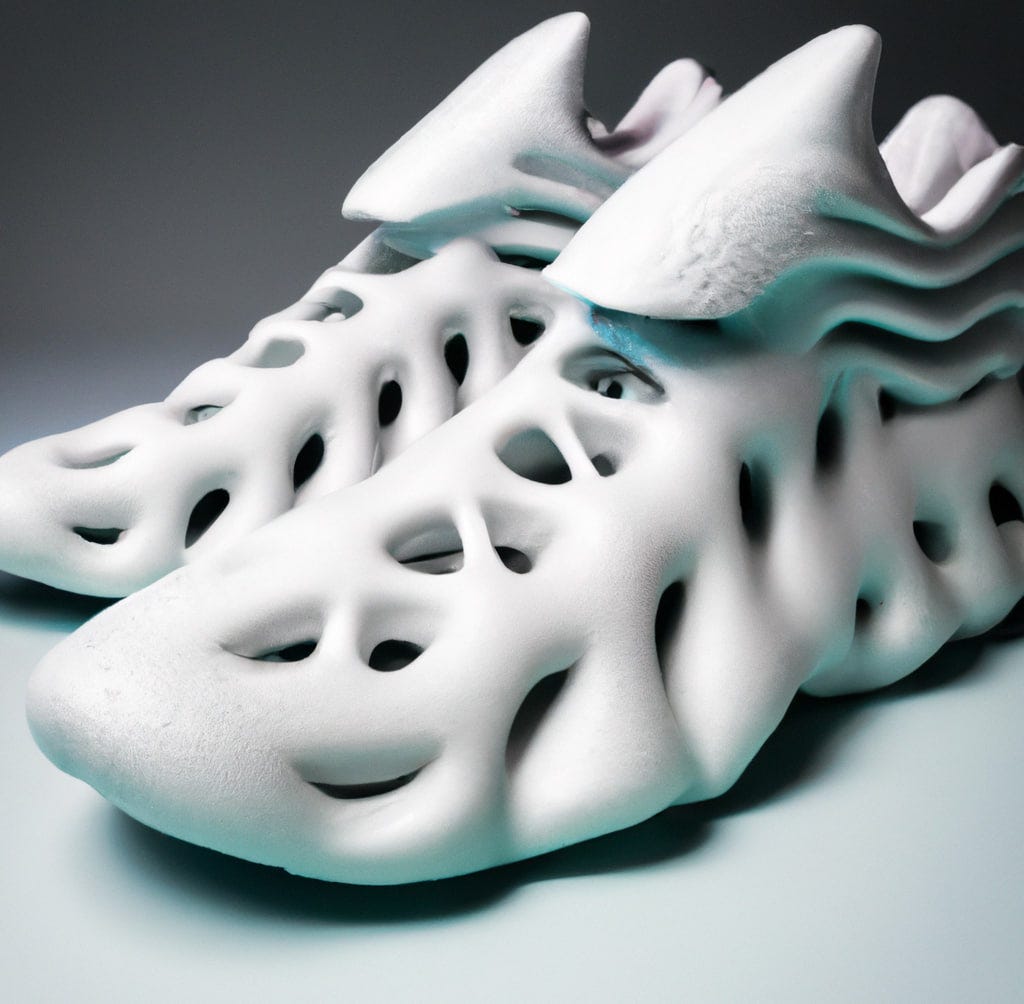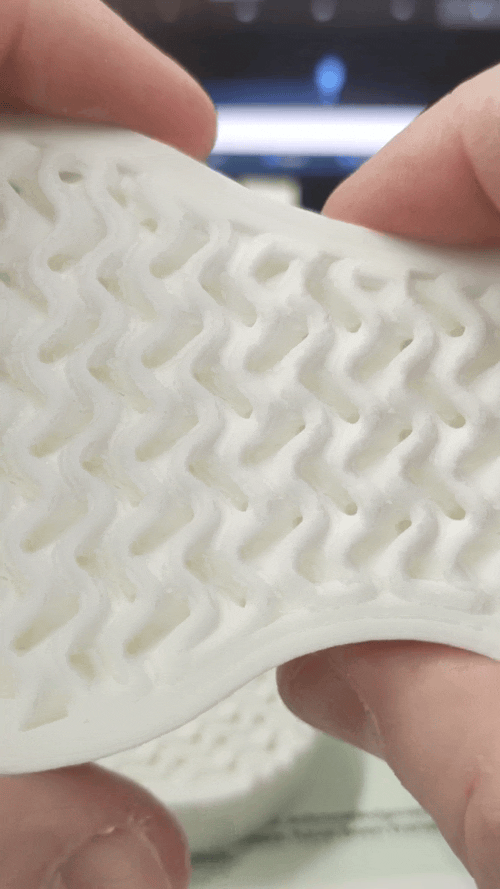How my PhD project might turn into Code Red for Nike and Adidas.
The story behind Elastium.
Hey there, my name is Robert Karklinsh. I spent the last years working on something that now might impact both society and environment in a positive way. And it also might change the footwear industry forever.
Just for fun.
Some may know me from Reddit posts (one, two) back in 2020-2021 about Unitruder which was the first desktop pellet extruder capable of 3D printing from almost any thermoplastic material, including metal feedstocks.
I started its development for my PhD work on metal 3D printing with feedstocks. But in the process I became a fan of idea to unlock almost any material for desktop 3D printing (e.g. printing in PEEK for something like $70/kg). I was even thinking of launching a Kickstarter campaign. Until on March 26th, 2021, I put some foaming agent into Unitruder. Just for fun.
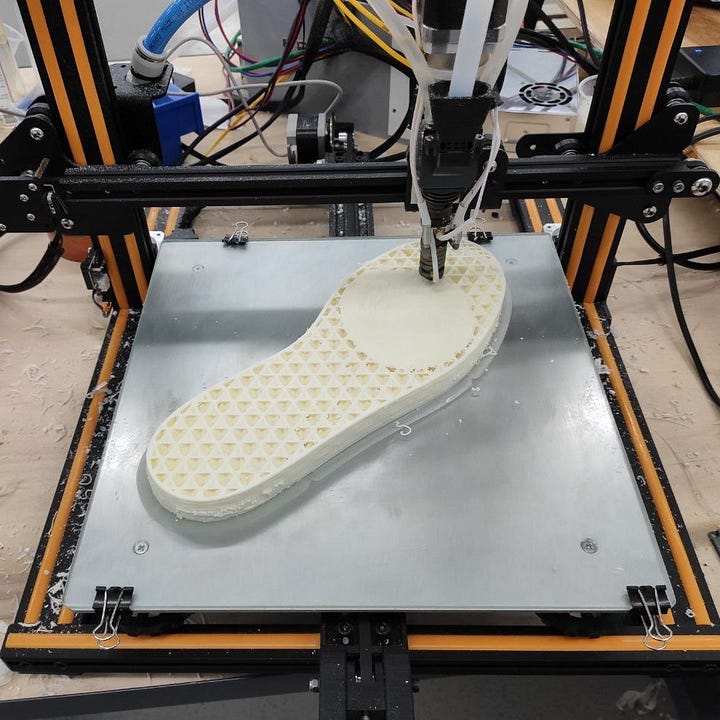
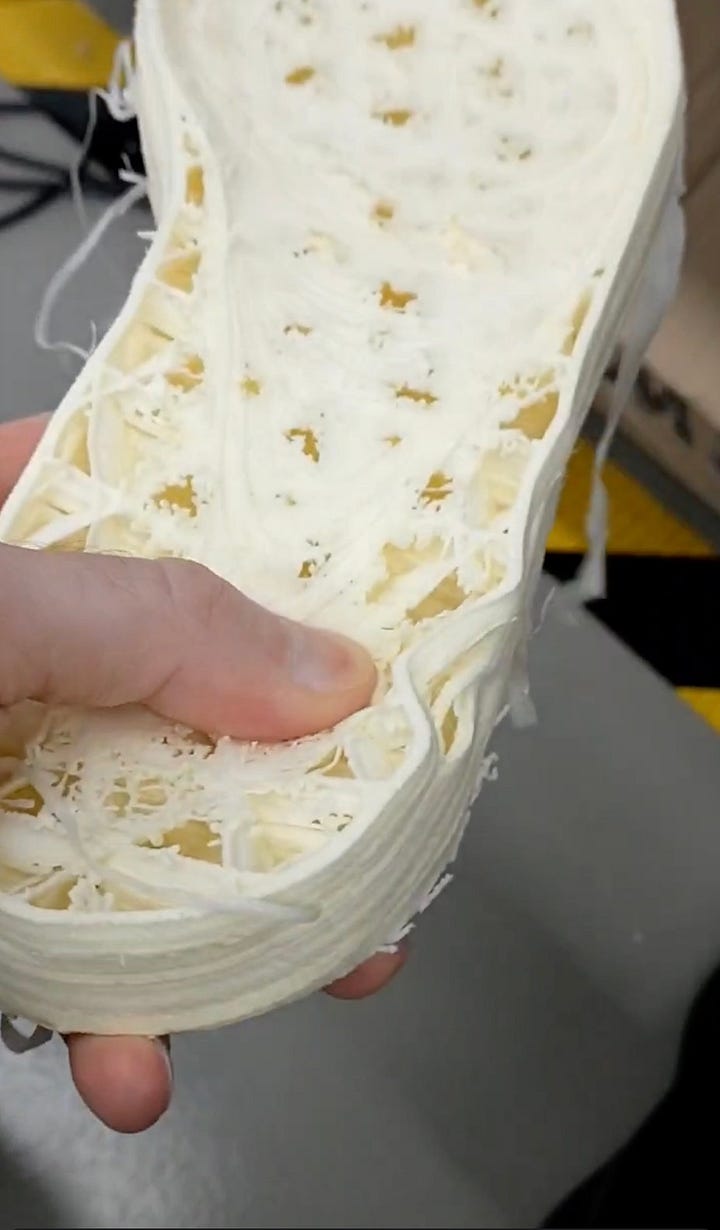
What came out was rigid, uneven, had zero interlayer adhesion and was yellowish. The list of problems could go on. I made several hypotheses on how to approach them. But for me as an engineer it was hard to give even 20% chance of getting anywhere near a production-grade technology. It was even more unconvincing knowing that probably nobody did it before for a reason. Or maybe they did and failed.
But the potential of it captured my mind. And it looked like adventure. So I made the silliest decision of my life and went all-in. I quitted my PhD to start a company and put everything that I had into it. Since then I’ve assembled one of the most competent teams in 3D printing business. Our team has battled through each and every problem which stood on our way to create the world’s first fully 3D printed sneakers made from TPE foam.
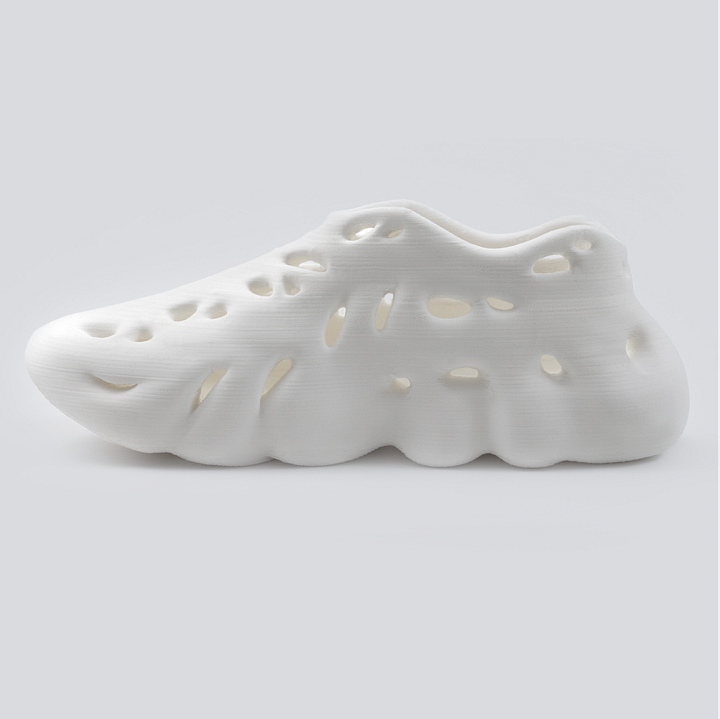
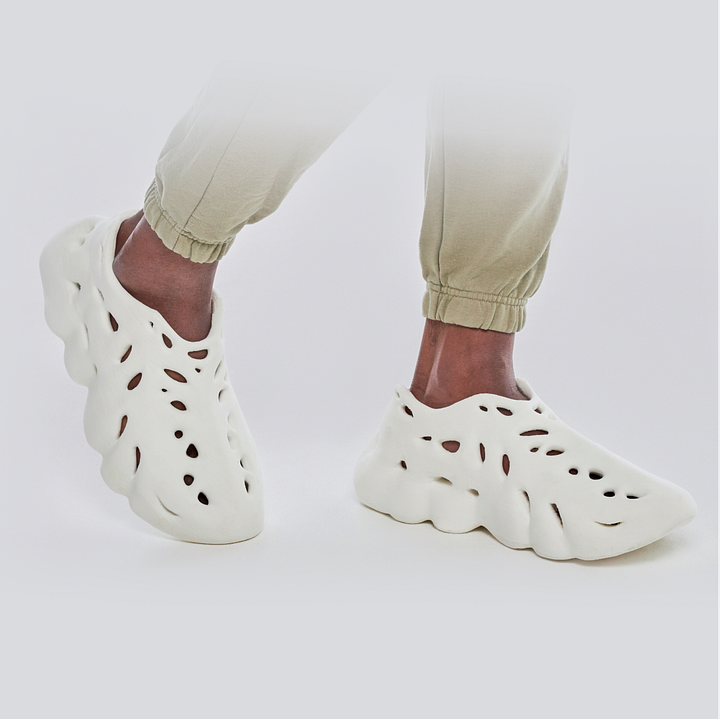
We are proud of our achievement as we now know crystal clear - our technology is ready to fulfil the promise of 3D printed footwear.
The promise of 3D printed footwear.
Personalization.
The most valuable contribution of 3D printed footwear is in the fact that every pair can be customized with zero additional cost. This customization must be realized in 4 stages.
1. Customization of discrete parameters.
This is a little advancement compared to traditional footwear. Still, you can play around with discrete dimensional parameters, cushioning, tightness and some features of the design with no extra cost.
2. Customization using a feet scan.
Imagine having a perfect fit every time your order footwear online. This will be done by making a scan of your feet with a smartphone. The design is then adjusted to perfectly match dimensional parameters of your feet and sent to a 3D printer for production.
3. Orthopedic customization for adults.
This will require not just a smartphone but a separate pressure scanner. Scanning service will be delivered to you or it can be provided outside at a dedicated facility. The data is used to print orthopedic insoles which can be integrated with midsole or made separate.
4. Orthopedic customization for children.
The endgame. Many conditions can be treated in young age with orthotics. But the time window to affect the structure of children’s feet is very small, normally until reaching the age of 5. And during this time children grow so fast that custom made traditional orthotics becomes a financial burden for parents. Hopefully, cost of 3D printing scales with volume of material in a roughly linear way making children’s footwear way more affordable than adults’ (in contrast to traditional manufacturing).
Personally, I have scoliosis because of uneven leg length which could be prevented in young age by orthopedic footwear. Hopefully my children are not going to have this problem thanks to 3D printed footwear.
Digital Ownership.
We already live in an era of AI-augmented design. Number of footwear designs grows rapidly. It is not possible to protect and commercialize footwear designs, which may have hundreds of small variations generated by machine, with a patent law. The only feasible option for creators to commercialize their designs is by selling them as a digital asset using the concept of digital ownership.
But to make the digital asset valuable it has to have value for its owner. What we now see is marketing teams trying to come up with anything that looks like value. They are leveraging network effects and extracting profits from communities by selling NFTs backed by some nonsense. Virtual sneakers? Community credits? Access to events? Personally, me and 99% of people don’t care.
To make the digital ownership work for footwear you need to implement seamless transfer of digital assets into the physical realm. And that is exactly where 3D printing shines and traditional manufacturing fails miserably.
Traditional manufacturing is very expensive and very slow in bringing digital assets into reality. It takes Nike at least 4 months to launch a new model after the 3D design is created. And it costs hundreds of thousands of dollars in engineering and tooling costs alone. With 3D printing it may take a couple of test prints and $50 extra bucks (aka 3D printing gas price) for a generic design. Overall, the total cost of the transfer is reduced by several orders of magnitude compared to traditional manufacturing.
With 3D printing digital ownership can be simply defined as a right to produce and reproduce physical copies of your digital asset. The right which is stored in ledger and can be traded freely. No BS.
Now when people find a design they love, they might actually care buying NFT to reward its creator and hold it for ordering more pairs for themselves, their family, friends, etc. Or maybe making some profits by selling it in the future. The consequence of all this is that footwear industry will become an inclusive space for work and creativity, and footwear fashion will become much more sophisticated.
Sustainability.
According to a study by Quantis, production of footwear is responsible for 1.4% of global emissions where manufacturing, assembly and transportation account for 65% of footwear emissions. Moreover, most of the shoes at the end of life are not recycled and end up in landfill. 3D printing can address these issues.
3D printing factories are continuously scalable and can be deployed almost anywhere. They can be deployed near consumers and scaled up or down depending on the demand or population density. This can drastically reduce the cost of transportation and recycling. They can also be deployed in areas with access to renewable energy. For example, for our company residing in the UAE there is a surplus of solar energy, and one of our goals is to create a 5k/month factory in daylight running on the solar power alone.
Fully 3D printed footwear (from thermoplastic materials) is also relatively easy to recycle. There is no glue involved. There is no need to separate different materials that make up a traditional pair. A fully 3D printed sneaker can be shredded into pieces and mixed up with virgin material in extruder to produce a new pair.
The plan.
To make fully 3D printed footwear mass adopted we need to produce at the same cost as Nike ($25 per pair). And our footwear needs to be as comfortable, light and durable as Crocs.
Material.
Like concrete for construction, the single most important material for traditional footwear is polymeric foam. Foam can be lightweight, soft and resilient. Crocs are so comfortable and light because they are made from foam. But the problem is that 3D printing with foams is hard. What 3D printing companies have been doing is replicating foams with 3D lattice structures.
Let’s say you want to replicate 0.25 specific gravity foam with lattice structures. To do so you need to remove 75% of material and make the remaining 25% in the form of lattice structures from a much harder material to have a comparable tensile modulus. It works well for midsoles. It does not work well for fully 3D printed shoes because such insole and upper, while soft on the macroscale, on the microscale are still hard. You can probably solve the problem with socks (in fact one celebrated company sells them together with their 3D printed shoes). But if you want something Crocs-level soft for wearing barefoot or something just nice to the touch, there is no alternative to foam.
Still lattice structures are very useful. They are resilient. They reduce printing time. They make the structure tunable. So here is what we actually are going to use: foam lattice structures (FLS).
This is the ultimate material for footwear 3D printing. Obviously, you can’t compete with FLS in 3D printing with either foams or lattice structures alone because those are just two extreme cases of it.
Technology.
We produce FLS-powered footwear with granulate extrusion (with lots of patent-pending sauce on top). Other possible approaches to 3D printing with foams are FFF and SLA/DLP. Our approach differs from these approaches in a number of key ways.
Cost. Granules are by far the cheapest material you can use for 3D printing. Raw TPU granules can be procured for $7/kg. TPU filament would cost around $12/kg to produce. PU resin would cost at least $35/kg.
Foam quality. Any foamable filament can be made in the form of granules and processed by our printheads in a thermodynamically equal way giving the same foam (at a lower cost of course). But only a tiny fraction of foams that can be produced by our prinheads can be replicated with filaments. And these are far from the best foams.
Multi materialism. In footwear you normally want soft material for the upper and more rigid material for the midsole. You also want your outsole from abrasion-resistant material. SLA/DLP 3D printing is inherently single-material. And although there are ongoing attempts to make it multi-material, they come at a cost of compromising the advantages of the technology.
Recyclability. We want old pairs to be recycled into new pairs. Resins are thermosets. Every resin pair (in the best case) will end up in incinerator or in a landfill.
Printing time. SLA/DLP is very fast. In contrast, all extrusion technologies are relatively slow. But filament extrusion is especially slow with soft materials. The softer the material or the higher the printing throughput - the higher chance of chewing the filament. Printing with soft filaments is never going to be as reliable or fast as printing with granules.
So we really like our technology. And we are pretty good at it. We can print in virtually any hardness. We can print in a wide range of densities, from fully dense materials to densities as low as 0.14 specific gravity. We can print fully 3D printed designs as well as assembled designs.

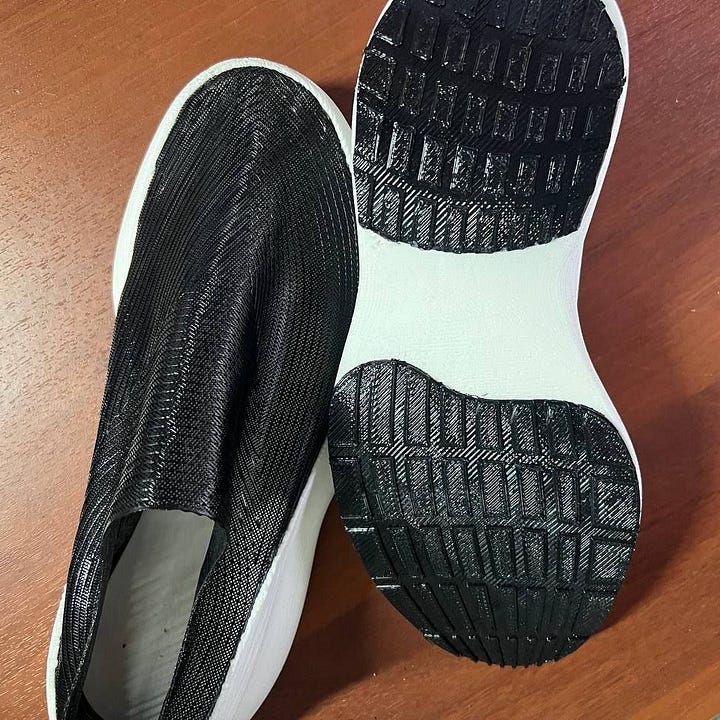
And all this knowing that nothing can beat us in terms of raw material cost and versatility. Not so bad, I suppose. Still the competition is going to be hot, and this is bad news for traditional footwear manufacturing and good news for end users.
Economics.
Here is a conservative breakdown of what goes into 3D printing one pair of ELASTIUM 1 sneakers size 43 EU.
Stubborn expenses. Let’s say foam costs $14/kg and support material costs $7/kg. Let’s say we print one pair in 20 hours (actually we can do faster). Let’s say the printer draws 500W on average. Let’s say we print it in the most expensive place in US: on Hawaii. In Honolulu electricity costs $0.4/kWh. Industrial space on average costs $215/year/sqm. Let’s say 3 printers can be stacked on top of each other and they together need 4 sqm of space. Let’s say 3D printer uptime is 80%. We have:
Material. 700g of foam + 600g of support material cost $14*0.7 + $7*0.6 = $14.
Electricity. 20 h*0.5 kW = 10 kWh cost $0.4*10 = $4.
Rent. 20 hours with 80% uptime cost $0.49*4/3/0.8 = $0.8.
Packaging. Roughly costs $1.
This adds up to $19.8.
Optimizable expenses. Let’s say 1 engineer ($80k/year+taxes) can keep from 10 to 100 printers in 80% uptime condition. Let’s say 1 personnel member ($50k/year+taxes) can service from 20 to 200 printers (load materials, unload 3D printed articles, etc.). Let’s say 1 printer costs from $2.5k to $10k to produce and has a 3 year depreciation period. We have:
Maintenance. Can be from $0.16/hour to $1.6/hour. Adds $3.2 - $32.
Amortization. Can be from $0.12/hour to $0.48/hour. Adds $2.4-$9.6.
Personnel. Can be from $0.05/hour to $0.5/hour. Adds $1-$10.
Total cost adds up to anywhere between $26.4 and $71.4.
To get close to $25 we need to concentrate on those things:
Make the machines as reliable as possible to drop maintenance cost.
Drop 3D printer production cost.
Make the factory as automated as possible to drop personnel cost.
3D print faster.
And we definitely will.
Of course, it is not very fair to 3D printing on Hawaii to compare it with a Nike factory in Vietnam. But it better illustrates my point: 3D printed footwear is here to stay. And needless to say, it is a good thing.


